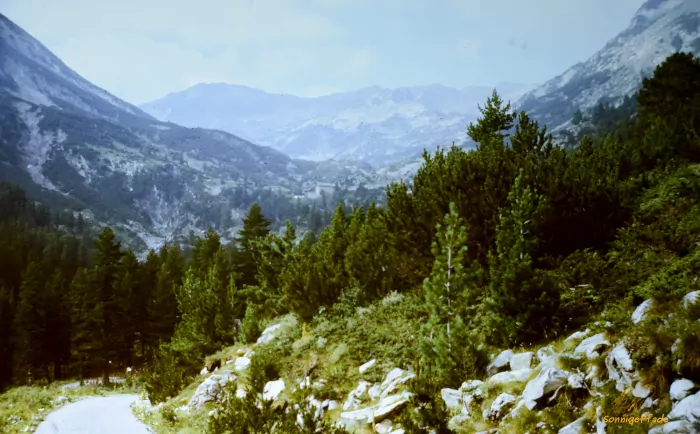
Last trip through the socialist brother countries 1989
Part 2 – find Part one here
The night in the waiting room of the railroad station of Русе (Ruse) is restless. A few extremely annoying flies are out and about, taking turns to harass the sleepy travelers. They don’t just land on the face and run a few laps, they specifically crawl into the nostrils and eyes. The skin layers at the entrance to the nose in particular prove to be extremely sensitive and also penetrate an overtired brain with their alarm signals. This shows how instructive cowboy movies can be: I take my big wide-brimmed black shepherd hat and put it over my face.
But that’s only part of the disruption. At least once an hour throughout the night, a train also arrives at this station. Especially the long-distance trains seem to run mainly at night in Bulgaria. Whether this is due to the fact that almost all international trains from the entire Eastern Bloc roll through the border station of Ruse, or whether people deliberately use the night to travel when the heat is not quite so oppressive – no idea. In any case, the large wooden waiting room – loudspeaker for each arriving train in full volume at least twice shouts its messages among the people waiting. Only those who have swallowed a bottle of sleeping pills at once can continue to sleep.
In addition, the swinging door of the waiting room opens again and again with a loud creaking noise. And it not only lets travelers through, but also two uniformed station patrolmen. They obviously have orders not to tolerate station sleepers. This means that they poke everyone who is lying stretched out somewhere with the baton a few times encouragingly against the legs. When I then sleepily straighten up my upper body, they are satisfied. When they have finished their round and leave the waiting room, I can lie down again. Until they come by again about 1 1/2 to 2 hours later and the ritual repeats itself.
Little rested I leave the station building around seven in the morning. The sun is already quite high in the sky and presses already with southern temperament into the landscape. Still somewhat disoriented, I walk through the city. But my mood is good, despite the restless night. Today I want to hitchhike to Софиа (Sofia), capital of Bulgaria, the sunshine and the joy of having finally arrived in Bulgaria keeps me in a good mood. I’m pretty sure I’ll make it to Sofia – where the friends from the Young Parish Community should arrive tomorrow.
In a grocery store, I buy a glass of yogurt to supplement my meager breakfast with something fresh. The range of food is incomplete and only partially corresponds to my eating habits. I have to change a bit and see what I can do with it. At markets there are huge mountains of watermelons, which are piled up right from the loading platform of the delivery trucks. There one can represent then with expert knocking and knowing grin the connoisseur and pick out what suitable. Peppers are also available in large quantities as fresh produce. Many farmers offer at their stands some jars with honey, in addition also Propolis (putty resin of the bees) in large dark brown blocks. But with it one must know already, how this medicine is used correctly and health-promoting. If you are not too late, there is also bread – big thick white breads that rumble when thrown on the counter. Many Bulgarians buy three or four of these at once; the bread is dry anyway and keeps for some time. I actually like the bread quite a bit (I come from a baker’s family on my mother’s side), but after a few days I miss the fiber of real brown bread. This then really starts to tingle in the stomach, real withdrawal symptoms, and takes a few weeks until it subsides. It is also important to mention the Шапска Сирен (Schapska Siren), the sheep’s cheese, which is now also available in German supermarkets. Together with fresh aromatic tomatoes a real pleasure. Well, with it a frugal wanderer can live already quite well…
I don’t stay long in the border town of Ruse, I start looking for an arterial road that will bring me on the right course to Sofia.
My hitchhiking experiences in the two years before in Bulgaria are good. And so it is also this time. After only a few attempts an old Russian truck stops next to me. And the destination is – Sofia!
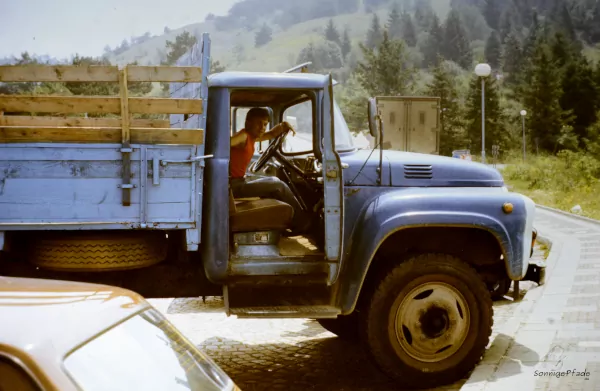
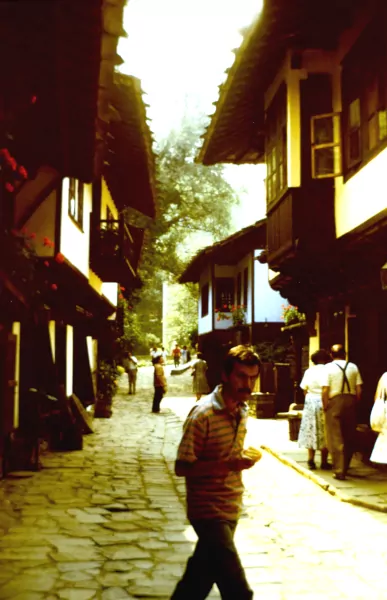
The driver is glad to have a companion for this long journey. It is still early in the morning and not too hot, but at a maximum of 80 km/h the truck needs the whole day for this distance. My backpack is put down on the back of the platform, because it’s pretty cramped in the driver’s cab. Then I sit down on the passenger seat and the journey begins. With my school Russian – knowledge I can make myself somewhat understandable and also some of that together rhyme, which tells me the driver in such a way. He is in his early 30s and works for a company. First we drive south, through the Danube plain towards the Стара Планина (Stara Planina) mountains. This mountain range runs through Bulgaria from east to west and separates the Danube plain in the north from the Марица (Maritza) plain further south. The first major town we reach is Велико Търново (Veliko Tirnovo), a place steeped in history with deeply carved valleys and a hillside with „Царевец (Tsarevets)“, the remains of the old Tsar’s residence. In the years before, this had always been my farewell place for Bulgaria. This time I am glad to see here known again.
Nearby is a museum village, Етър (Etyr). My driver does not miss the opportunity to stop there especially for me. We wander together for some time through the historic cobblestone streets.
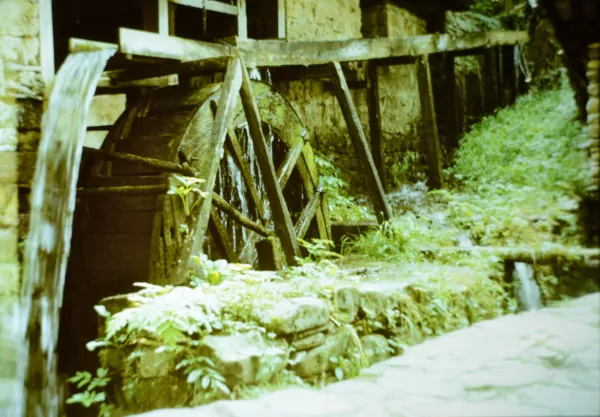
Then begins the ascent over serpentine roads into the Stara Planina mountains. With difficulty the small truck fights its way up into the mountains. We cross the peak on the Шипка (Shipka) pass (1308m). This is also a historical place. Many a battle has been fought here. Among others, against the Ottoman Empire, which the Bulgarians managed to defeat together with the Russians, thus liberating the country. This trial is still remembered in Bulgaria today. It is the foundation stone for the fact that the Bulgarians, in contrast to the other Eastern bloc peoples further north, have a very friendly relationship with the Russians. Stalinism and the communist period did not change that too much. While with Czechs and especially Poles we could switch to Russian (which everyone had to learn in school) only after some detours and not very successful attempts to English (which is much harder for Slavs to learn), in Bulgaria it was never a problem to speak Russian right away. Since the languages are very related, the Bulgarians understand it quite well. For us, the big advantage of learning Russian was that we could already read the script in Bulgaria, which is also Cyrillic. And we were able to decipher a lot of the word stems, so that we were able to guess the content…
At the Shipka Pass there is a big monument to one of the historical liberation battles of that time. And not far from it, on the slope of Бузлуджа (Busludsha), an (even more monumental) memorial to the founding of the Bulgarian Communist Party with a 70m high symbolic flag and a conference hall for over 700 guests, which looks like a UFO landed in the mountains. However, I have not yet been able to find out whether the latter monument to heroes is still standing today.
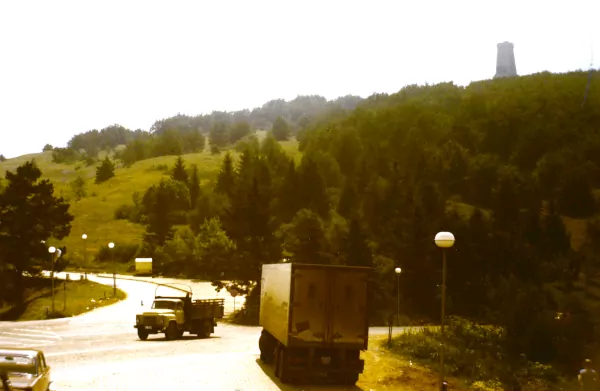
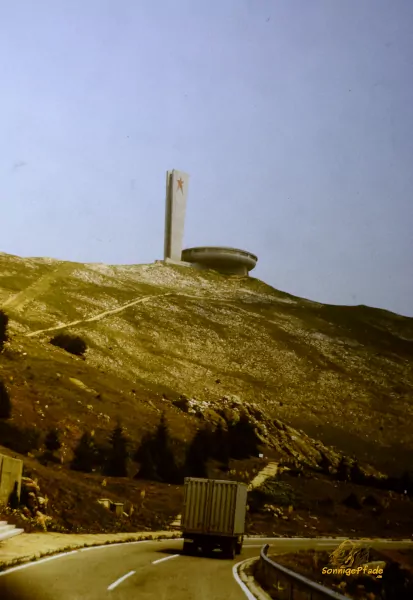
Bulgarian Communist Party
At a rest stop in the mountains we take the next break. My driver is hungry and I also want to take the opportunity for a refreshment. Unfortunately, the offer is relatively limited. From my vegetarianism – conversion (see in part 1 ) I must take here temporarily distance. The only thing that appeals to me in the food offer are Гебапщета (Gebaptscheta) – a kind of fried minced meat rolls, thin meatballs in sausage form. They are also quite okay, with toast and tomato slices an acceptable snack. Especially since we are not talking about Holland tomatoes, which did not exist in the Eastern Bloc. Aromatic tasty sun-ripened Bulgarian tomatoes 🙂;-)
As we want to drive on, a young man speaks to us. So we get another passenger for the next kilometers. Now it goes downhill, down into the sun-drenched „Valley of Roses“. This is a smaller side valley of the Maritza plain, separated from it by the Средна Гора (Sredna Gora). Here on endless areas grow a lot of roses. Not for cut flowers, but for the extraction of rose oil. Well, I was allowed to sniff such a bottle once. It wasn’t exactly my cup of tea – in my opinion, there are nicer scents. But if some like it and people here are quite proud of a typical product, I’m glad. After all, there is probably a long tradition of rose oil – production in the Rose Valley.
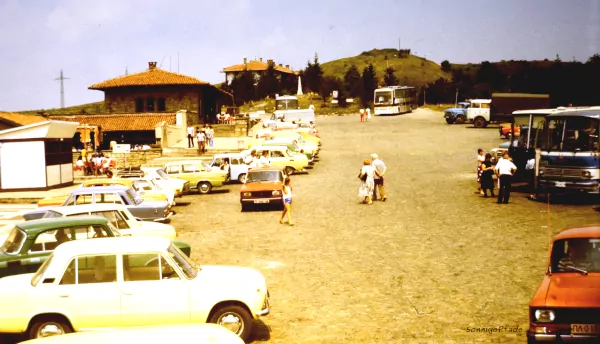
The heat is increasing. On the one hand this is due to the advanced time of day and on the other hand because we have passed another mountain range, the Stara Planina, which separates us from northern influences. Now our main direction of travel points to the west. I.e. my side of the driver’s cabin is at least still in the shadow of the northern side. The driver sits at the window in the blazing heat of southern sun. With 70. 80km/h the truck tortures itself over the dusty roads.
In the afternoon I notice that the driver is getting more and more tired. The heat leaves its traces. Soon I start to massage his shoulders from time to time. We are already on the road for almost 10 hours. Only in the evening we reach the greater Sofia area. I already notice that we are driving east around the city center via one of the ring roads. I.e. we come into the south of the city. The driver knows my destination – and indeed he does. He drops me off right in front of one of the campsites. I fish for my „Kraxe“ bagpack on the platform behind the driver’s cab and thank him again in detail. Wrapped in a cloud of soot, the truck jerks away.
Then I enter the campground where I had been two years before. In a corner, somewhat hidden behind larger tents, I lie down on the grass. I do not have a tent. With my would-be Tarp blanket I cover myself and my Kraxe and fall asleep completely exhausted.
The next morning begins Bulgarian – sunny. Nothing else I expected. I take a city bus to Централна Гара (Centralna Gara), the main station of Sofia. In the course of the morning, the Pannonia Express from Dresden is supposed to arrive there and with it a group of young people from a friendly parish youth community. I am on time and the train is surprisingly also on time. That is not always so, among the East German Traveller circles circulate stories of up to 12 hours of delay. These are certainly absolute exceptions. But with a total route from Dresden via Prague, Budapest, across Romania and then in a large arc through half of Bulgaria, the regular travel time is almost two days. That can add up to a couple of hours – especially due to excessively long border controls.
When the train finally rolls in and the first stiff-seated passengers trickle onto the platform with their luggage, I start looking. And it doesn’t take long to see astonished, surprised faces. „… here we are driving for two days through half of Europe, and then we meet the same people as usual“ or something similar are the first comments. But Manfred, the youth leader, is quite happy to see me here. After all, I am the oldest after him and have some travel experience, while there are even one or two minors in his group.
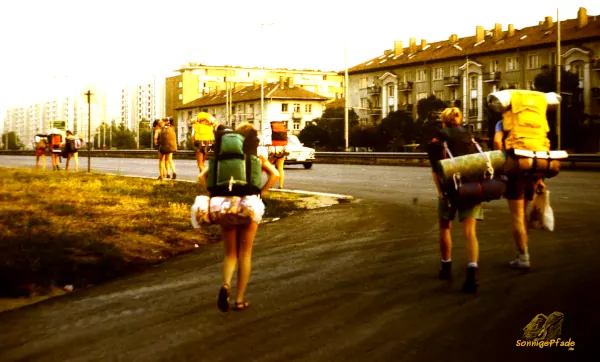
The campground is the first destination. After all, everyone wants to get rid of their luggage and freshen up a bit after the long ride. The washrooms in the couchettes and the water stations at the train stations are somewhat uncomfortable places for personal hygiene. In the afternoon we make a few rounds through the city. But it is not so much the theme of the trip, even though a visit to the Александер Невски (Alexander Nevsky) Cathedral is already impressive. In the evening we first exchange our experiences so far.
The next day starts with the way back to the train station. We take an express train to Септември (Septemvri). There a narrow-gauge railroad branches off to the south from the main Sofia-Plovdiv line. At the beginning it is quite nice and exciting to be on board of this small narrow-gauge train, especially since we quickly leave the flat land and the rail tracks wind up the mountains in wide serpentines. But little by little, the ride, which doesn’t exactly reach express speeds, becomes quite monotonous. And the heat is pressing again. All windows are open, a warm air stream blows through the wagon. We doze on the seats and look dreamily outside at the passing landscape. Some pass the time playing cards, reading, telling stories. But it doesn’t make the trip any shorter. Nevertheless, for me this is part of the journey, of being on the road, an experience. Again and again, locals get on or off, we pass villages, fields, see smaller towns. School children ride along a few stations on the way home.
Finally, the train arrives in Банско (Bansko) in the evening. This small town is located at the foot of the northern, the highest part of the Пирин (Pirin – mountains). And this is our common goal. But for today we stay right at the remote train station. Right next to it there is a small park-like green area. There we lie sleeping bag to sleeping bag. The water point on the station is for us water dispenser and shower at the same time.

The next morning a bus takes us up to the mountains, directly to the Вихрен (Vichren) – hut at 1950m altitude. The asphalt winding serpentine road reaches up to it. What a comfort! Unfortunately, there are also a lot of cars going up there. Next to the mountain hut there is a small camping site. I already knew it from the previous year, when I walked through the Pirin with a study buddy. But then we had to break off – it was mid-September, and when we looked out of the tent in the morning, there was snow outside. Now, in August, the sun shines down on us warm and bright – best weather for the mountains. So we first set up the tents. Since I only have my tarp blanket with me, I move in with Manfred. He is the boss of the group. Then we set up the stove and prepare something to eat. In the afternoon then a first exploration – walk. Just walking along some of the mountain paths, enjoying the great air and the beautiful weather. To get used to it not so bad.
In the evening we sit together in the round and tell. Of course, we are far from being the only „Ossi“ (East german) youths here. Every year crowds of them set out from the GDR (former East Germany) to conquer Рила и Пирин (Rila and Pirin Mountains). After all, in Rila there is the Мусала (Musala peak), one of the highest mountains reachable for normal GDR citizens (2925m) and peak Vichren here almost in front of our nose is not much lower (2914m). Sure, some always dreamed of the even higher mountains and some went on the adventurous tour, only with the „transit visa“ which was actually only valid for 3 days, through the Soviet Union to the Elbrus, one of the Caucasus – peaks. For it in the 80’s the term „udF“ came up, „unrecognized through friend country“ (in german: Unerkannt durch Freundesland). I have also thought about it… less because of the Elbrus, but so some regions in the Soviet Union had also an attraction for me. But so far there were still enough places for me to discover in the accessible „brother countries“, there was simply no pressure to move illegal into the dark gray areas. But such thoughts and legends from hearsay came up in the chatter rounds at mountain huts and campsites every now and then.
The night becomes a… cold. With my super sleeping bag, I’m probably the only one who hasn’t frozen and crawls out of the tent in the morning in shorts and bare-chested. Everything outside is dewy and icy. But the sun rises quickly over the surrounding mountain ridges and laughs from the blue sky. It gets warm again and breakfast lifts the spirits with hot tea and jam – breads. Today the ascent of Vichren is on the program. Right after breakfast we start. From the campground we can go up there without luggage, which makes things much easier. If you want to go further north over the Vichren, you have to carry everything with you. Over serpentine paths we climb up. The tree line we have soon behind us, the hut is already at the upper edge. The view widens over a huge valley incision surrounded by high, rocky ridges. Our paths run along the western slope. In between, again and again slope meadows with partly very beautiful colorful flowers.
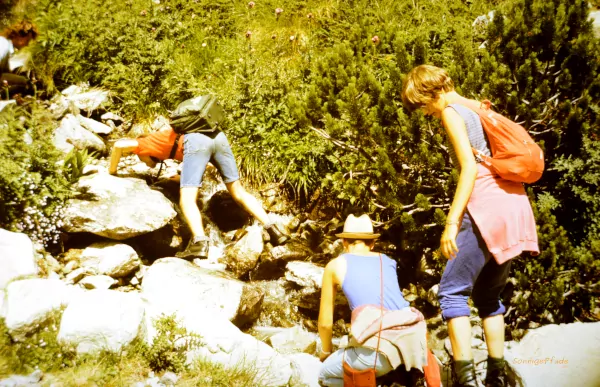
When we reach the ridge, we already have a fantastic view over the Pirin Mountains. Only to the north the view is still blocked, because there is now the peak of Vichren in front of us. And it towers over our viewpoint by a few meters. Moreover, the rock changes visibly – the summit of Vichren is predominantly white marble. This makes the climb even more difficult – the paths are often quite slippery.
Despite the sun, the air is cool. But very pleasant, really nice mountain air. And freeze is also not, the efforts already drive us the sweat on the skin.
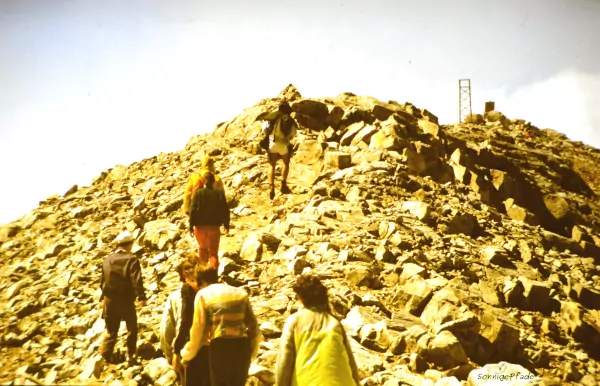
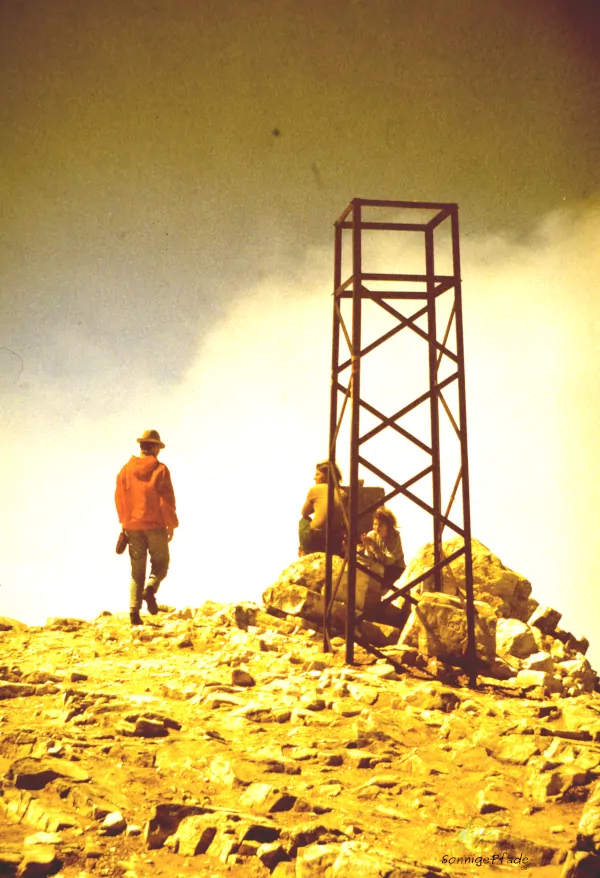
At the top there is a small summit plateau with a ridge to the east. The „summit cross“ is an iron lattice – mast, about 4m high, all nothing special. On Musala summit, the highest peak in Rila mountains, there is a weather station. For a small fee you can get an aromatic mountain herbal tea and a summit stamp. On the Vichren the view is the reward. And we enjoy it for over an hour. The girls have wrapped themselves in windbreakers and long training pants against the cold draft. Manfred is just on the Tai Chi trip and makes first demonstratively a few exercises. On a snow field a small snowman emerges. Transient companion of the mountains…
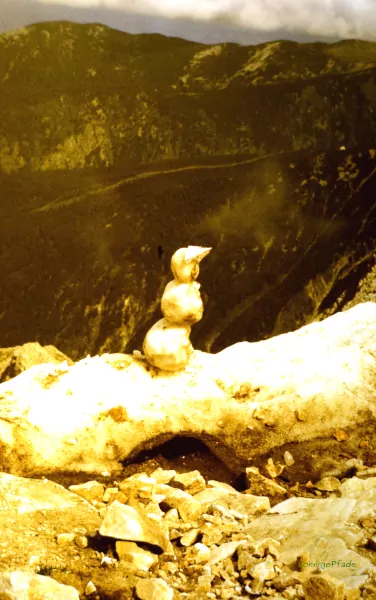
The descent is more strenuous, especially on the calves. Because one must always brake with stretched feet and intercept oneself from the far steps. But at some point it’s done and we’re back on the campground.
Tomorrow it should really start with the hike. Southwards through the Pirin mountains with the destination Мелник (Melnik). Two of the girls, two sisters, tell us in the evening that they don’t want to walk through the mountains with luggage. After the „summit“ today, which was not so easy for them either, they do not dare to do this tour. Therefore we discuss how to deal with it. Manfred decides to drive around the mountains with the girls. The best way to do that is hitchhiking. But for three people it is not that easy. So I will join the hitchhiking tour and only hike from Melnik in the opposite direction through the Pirin.
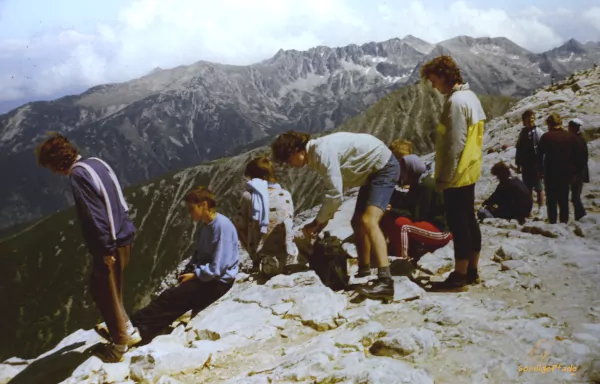
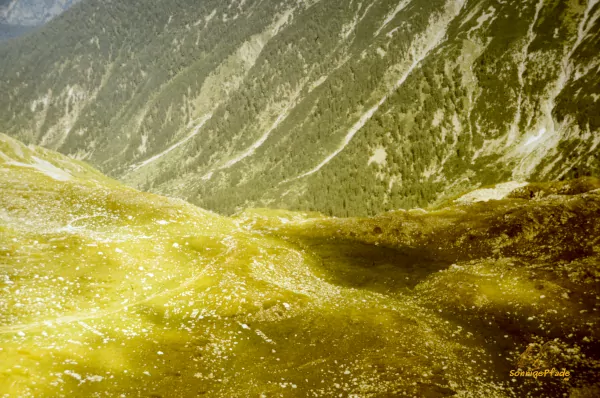
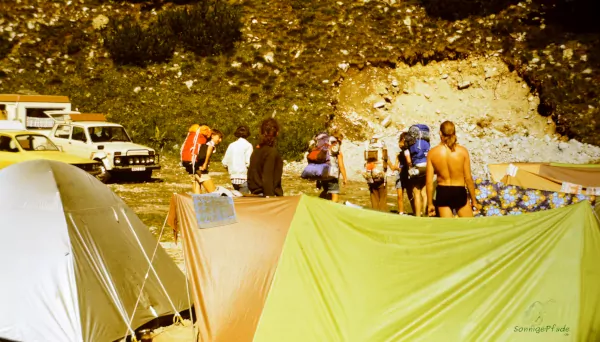
The rest of the group walks off the other morning. We wish good luck and wait at the hut for the bus that will take the four of us back to the valley. In Bansko we want to split up – one girl, one guy. But who with whom? O.k., I don’t feel like long discussions and just start walking along the road. One of the two will follow. So it happens. Well, the second one is not yet of age, so it’s better if she stays with the youth leader, who is also „officially“ responsible. So I get the older one. After a few meters, I stick my thumb out as the first car approaches. And off we go – first to Разлог (Raslog). The road leads here, parallel to the tracks of the narrow-gauge railroad, completely straight northward through a plain. This divides the mountain world into Pirin in the south and Rila in the northwest.

When we are around the northern tip of Pirin, from north to south opens the valley of Струма (Struma river), which continues to flow to Greece. Here a main road from Благоевград (Blagoevgrad) runs west of Pirin. Once again I keep my thumb out. This time it takes a little while. But then a man with a Lada car stops. Anna gets in the front, I sit on the back seat in the middle. There I can join in the conversation. Especially since I’m the one who knows the way. Anna is supposed to have been good at Russian in school. But unfortunately she is completely inhibited now, and answers the driver only „Я не понимаю. (Ja ne ponimaju- I don’t understand)“ So I always have to translate for her the questions that the driver actually addresses to her. „Just tell him what your name is… He now wants to know where we come from…“ Well, with my Russian 3 in the school leaving examination I am proud to shine a little bit here. It’s not about nerdy knowledge, it’s about finding your way out there.
So we reach Ново Делчево (Novo Delchev), where we want to meet at the bus station. The other two are not there yet. We first look for something to eat and then a shady place. The sun is now pushing full into the city from the southwest. The afternoon turns into evening. Students are on their way home, old farmers‘ wives are packing up their things from the market stall. My companion is getting increasingly restless. She is worried about her younger sister. I am actually still quite calm, only the increasingly negative statements of Anna are a little annoying. That goes up to the statement “ … there must have happened“. “ what am I doing, my parents… I’m responsible…“. My objections that hitchhiking doesn’t always go as smoothly as it does for us today, and that sometimes you just stand in stupid places where hardly anyone stops, fall more and more on deaf ears. „How can you stay so calm….“ yeah well, I guess I’m a little heartless 🙂
When the two finally arrive, the sun is already sinking quite violently towards the horizon. They had even left before us, but only as far as Raslog. And then it went on slower and slower. Simply bad luck.
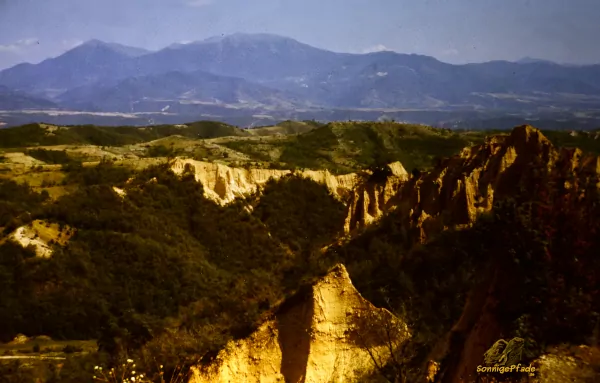
Fortunately, there is one last bus to Melnik. Hitchhiking there would not be easy, especially at such a late hour probably almost impossible. Because Melnik is considered to be the smallest town in Bulgaria, it is a bit off the beaten track and doesn’t have that many inhabitants. Anyway, we arrive at the campground at dusk. It is located a little bit outside of the center on a meadow at a brook. Next to it runs a gravel road that leads up into the mountains. The year before, that was already in September, the shepherds came on this way with their flocks already from the mountains – playing the flute, the sheep well-behaved behind. Now the warmth accumulates in the valley incision – no one needs to freeze here at night.
We now have a few days until the other group has passed through the mountains. There we already have a look at the place and make a few hikes in the surroundings. Here south of the Pirin the heat is obviously even greater. Under noon the air shimmers, crickets chirp and the sun burns on the skin. There remains only the possibility to withdraw somewhere in the shade and to make „siesta“. Of course, this is immediately a topic of conversation. From the GDR, we only know that people go to work or drive early, stand at the assembly line from 7 a.m. on or wherever, and finish work after 4 p.m. The southern mentality is often talked about in a derogatory way. A break of several hours at noon – where do you find that! No wonder they don’t get much done with their obvious laziness….‘. That one creates nothing anyway with the heat and that in these southern regions the life goes off after around 5 only again so correctly, is overlooked naturally gladly. Fits yes also not in the own world view. In any case, we are happy to adapt here and look for a shady spot for the early afternoon hours.
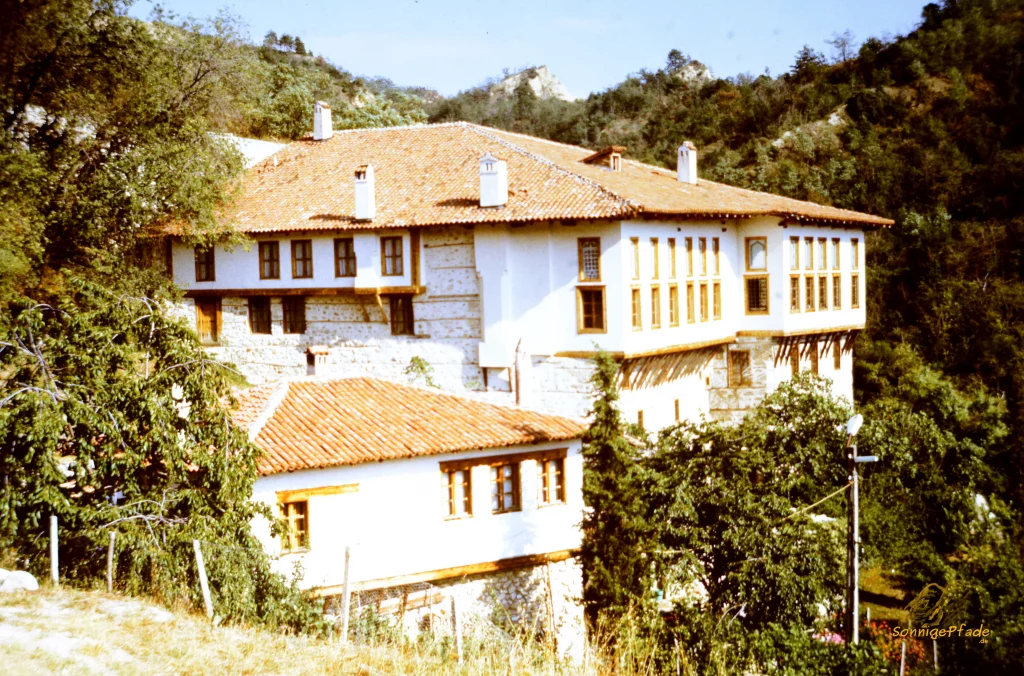
The houses in Melnik are quite large, the smallest town in Bulgaria must have always been quite prosperous. Melnik is situated in a valley between sand mountains. They are really deep erosion gullies. The talk is always of sandstone, but if I compare it with the Saxon sandstone, there the emphasis is on „stone“, in Melnik on „sand“. A mixture of gravel, sand and clay, deeply washed out. The houses partly nestle into these gullies. They are multi-storied, mostly of whitewashed masonry with single large stones and some swell beams running across. The roofs are flat hipped roofs, traditionally covered with „nun and monk“. Some porches or terraces are boarded with dark wood. Many of the houses in Melnik are in good shape, tourism is obviously promoted here. Only some of them are nevertheless in acute danger of decay.
Melnik is known for its red wine. A small but noble wine-growing area surrounds the town. Wine is pressed in deep cellars dug into the sand hills. The evening belongs to the visit in a Mechana, a wine tavern. There is a spicy meal with Шапска Салат (Shapska salad, tomato salad with white sheep’s cheese) and white bread as well as wine in earthenware cups. For a group you can order a liter – jug of wine at once. If you are lucky, a local dance band will also play, and the atmosphere will rise quickly and with hot blood. I have seen several times wedding parties in Bulgaria, where practically all were to Balkan – Music in large row dances.
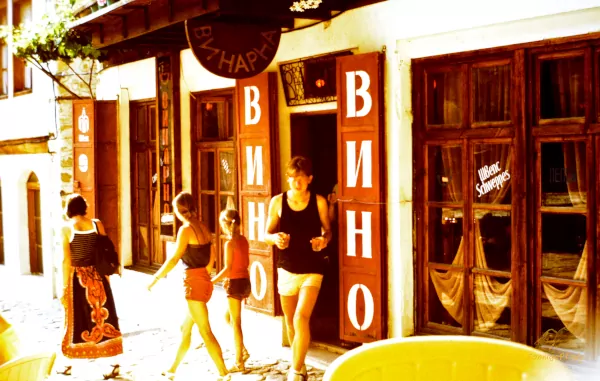
There is a big hello! The others are back, they have made their tour through Pirin mountains.
That is, in the evening we all meet in the outdoor seating of a wine tavern. We had already scouted it out and marked it as very pleasant for our group. In the shade of trees and vines, we sit at round tables, of which we have immediately arranged a few.
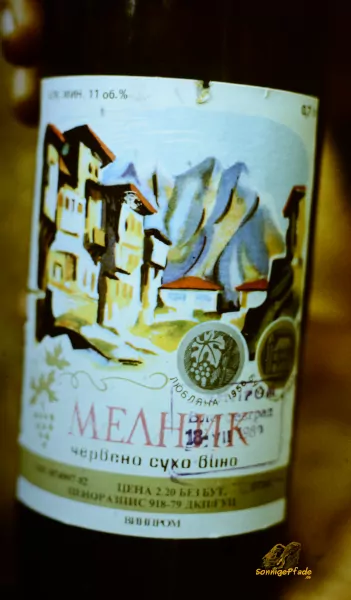
Typical tablecloths made of coarse wine-red fabric cover the rustic furniture. Of course, there is also Schapska salad, as well as stewed vegetables, and, as always, white bread. And cool red wine in a jug. The guys and gals talk about their tour through the mountains. The air is warm, even as the sun slowly takes its leave. We sit for a long time before we go back to the campground in the darkness. Street lighting is quite sparse even for us learned GDR citizens.
The next day we take a hike to the small neighboring village Рожен (Roshen, sh as second g in garage). Our path leads through the typical sandstone mountains of Melnik. Dry, hot sand. Thorny bushes, again a lot of crickets chirping. Lizards scurry left and right across the path. There are supposed to be snakes and even scorpions – but we didn’t see any. The paths are dusty and wind sometimes through the canyon-like valleys, sometimes over one of the sand hills. Some of the clay sand stones are so washed out that they only look like a column on which a large round granite – stone lies on top. This then kept off the rain and protected the sandstone column like the style for a mushroom from washing out. Impressive and fragile.
In Roshen there is an old monastery, the Роженски Манастир (Roshenski Manastir). However, this is no longer in operation, but Bulgarian state museum. Thus, visitors can crawl to the last corners without bias and do not disturb monks during devotions. In front of the gateway is a Barkas (east german camper car) with an open back door. A tangle of cables hangs out of it – a film crew is on site.
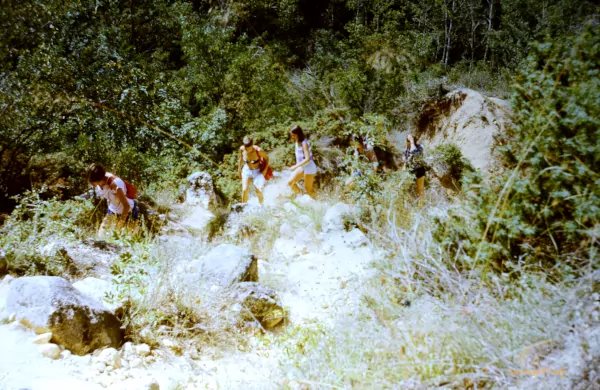
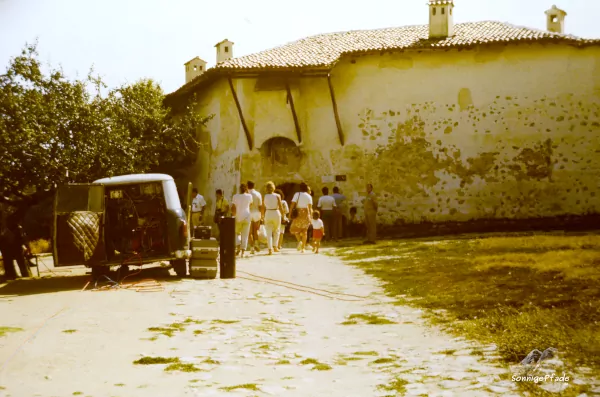
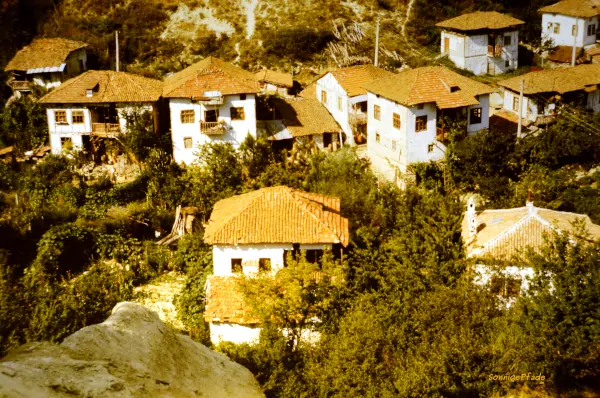
The Orthodox monasteries always impress on the one hand with the stylish buildings, beautiful churches and idyllic courtyards. But on the other hand also with the iconostasis, the wall of icons in the churches. Icon painting is a great art of the monks in the territory of the Orthodox Church. Many paintings seem so colorful and vivid that one could almost think that the figures could leave the wooden panels at any moment and join us.
While the village lies in another sandy erosion valley, the monastery stands on a grassy hill. Everything is dry. A few scrawny trees form the roof of a scattered fruit meadow where a donkey is pegged out to graze. On the southern slope we spot a large yellow tin sign. „ACHTUNG GRENZE ZONE“ (Attention Frontier area) is written on it in German (!). Under it smaller and also in German: „Entrance without special documents strictly forbidden“ Melnik and Roshen are only about 10 km north of Greece. This makes us dream of course… „now still an island tour through the Aegean to connect, that would be nice!“ The Chalkidike peninsula is not far away, Thessaloniki is the next big city in Greece. The road from Blagoevgrad, over which we hitchhiked, also leads there. However, in between lies the border crossing Кулата, and it is insurmountable for us… yet. There are probably some GDR citizens who consider the Bulgarian borders less secure and prefer to try to escape over the Iron Curtain here. That this is not so, many learn only by rumor. Allegedly, every week during the summer months, a special plane would bring captured fugitives back to the GDR. Well, in the summer of 1989, other possibilities opened up for east german citizens willing to flee. The erosion of the Eastern Bloc was already in full swing.

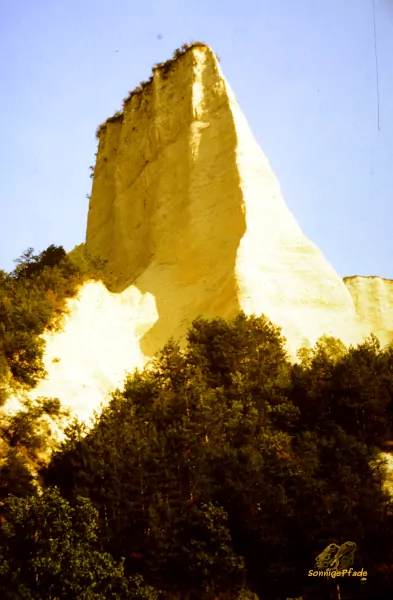
The next day we laze in the sun. Behind the campground, a clear mountain stream flows into the valley, with beautiful cool water. There we sit naked sometimes in, sometimes at the water and let the sun shine on our … Belly. Some dense bushes shield the stream from the eyes of the locals. That is also good – already in Southeast Europe the culture break begins. Naked people in public is quite indecent behavior even for Bulgarians. Of course, the young people are already a bit more relaxed, but the strong contrast are many old mothers standing in the garden in the heat with thick black dresses and black headscarves, or old men with shirts, sweaters and thick jackets.
In the evening we are back in our favorite wine bar. Today there is even a band playing. Together with Bulgarian guests we dance along with the step dances and have a great time. Unfortunately, towards the end, some of the guests become a bit pushy towards our girls. Relatively revealing clothing in connection with abundantly enjoyed wine probably leads to the assumption that otherwise quite open-hearted manners are appropriate. Since we wanted to go anyway, we take the girls in the middle and remove ourselves as quickly as possible.
On the other day, it’s time to leave again. And for me the separation from the group. At least some of them want to go to the Black Sea and enjoy a few days of vacation. I want to hike in the opposite direction over the Pirin mountains. So we say goodbye to each other in the morning. While the group gets on the bus to Nowe Delchev, I start the ascent over a forest road. I am not alone. On the campground I have already met a Dresden guy in my age, who has the same way. Jan is in Dresden in a mountaineering group and still has a lot of plans. The hike through the Pirin is simply a training route for him. In the years that follow, I always get a postcard from him – from the Caucasus, Tinschan and also from other peaks that I don’t even dream of. I know my limits.
As I already know from the previous year and from the much shared experiences of others, timber trucks are happy to stop for the first part of the way. We succeed also and we can save so some kilometers of boring grit way simply. We are not the only ones – on the open loading area are already some backpacks and the owners cling to the stanchions.
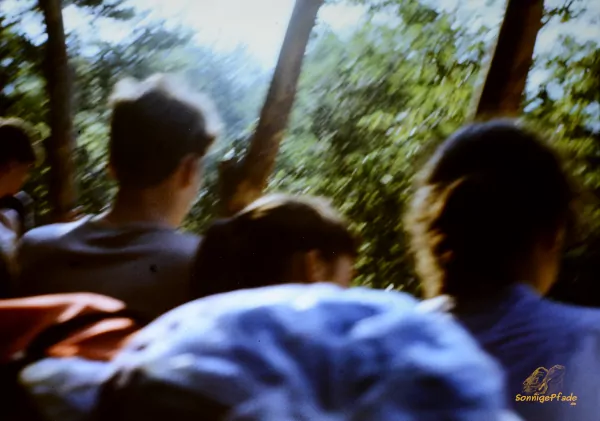
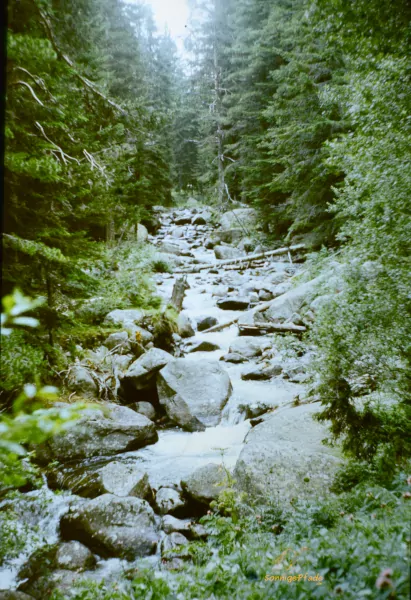
When the forest workers let us down, we are already almost through the forest zone. On a slope meadow we discover a mirabelle – tree, which hangs full of overripe fruits. There we do not let us ask long and approve us first of all a proper vitamin – push. Then the ascent begins. Above the forest zone there are extensive plateaus with herb meadows. There the way leads past a sheep farm. One of the herding dogs follows us on the foot. I don’t want to have any trouble with him. The Bulgarian shepherd dogs are big, strong, very special animals that can even successfully fend off bears. They have to, because there are brown bears and wolves in the Bulgarian mountains. Friends once told me that they woke up at night while wild camping in the Rhodope Mountains. Beside the tent was a heavy animal, which plowed there probably some earth and bushes and thereby loudly growled. But so far I have been spared from such experiences.
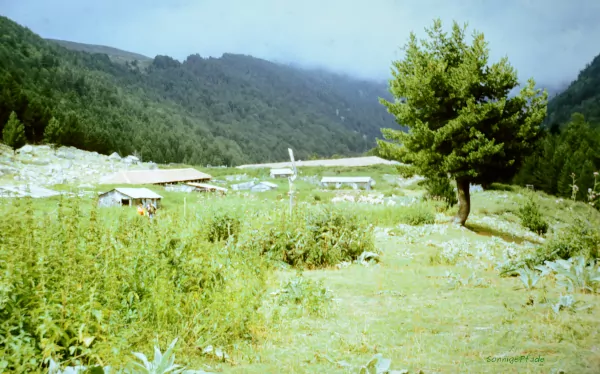
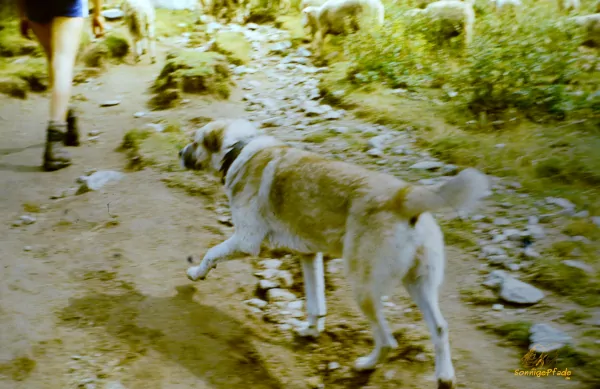
It goes higher and higher. The climb becomes steeper and stonier. Every now and then we have to cross scree fields, which is the most exhausting.
After a steep ascent we make it in the afternoon to the saddle next to Kalew Dwor – Калевдворска дясна порта (Kalewdworska Djasna Porta). This is, in a way, the entrance to the highlands of the southern Pirin mountains. The view extends to the north and northwest over the vast mountain ranges. Now we continue slowly over a few contour lines into a valley basin. There the blue water surface of the Тевното езеро (Tewnoto Esero) shines at us from afar. Next to it there is a relatively small mountain hut. This is our night quarters. The hut consists only of a narrow room and a mattress camp under the pointed roof. There are already some hikers here, but there is still enough space for us. By rolling out our sleeping mat and sleeping bag we „reserve“ our sleeping place. Then we get a hot mountain herb – tea in the guest room. The toilets are outside – a Plumsklo – cottage about 100m from the hut. Most of the huts in the Pirin Mountains are located further down and are even accessible by roads. Tewnoto Esero – hut is isolated and accessible only by hiking. Unfortunately, for some, garbage disposal is the task of others. Well, and if no garbage truck can drive to the hut, not my problem. Anyway, hidden behind some stones are a lot of cans, glasses and plastic bags. Partly rusty, partly still relatively fresh. What particularly annoys me are some cans whose labels undoubtedly reveal their East German origin – Hal-Ko liver sausage from Halberstadt, Eberswalde sausages, Saßnitz fish preserves and others.
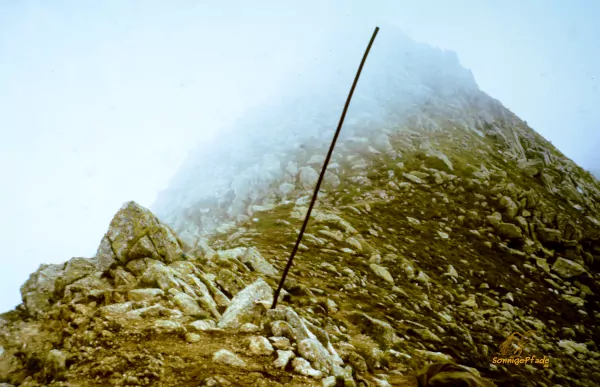
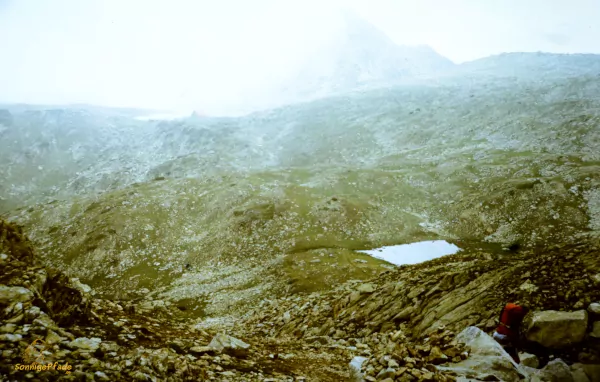
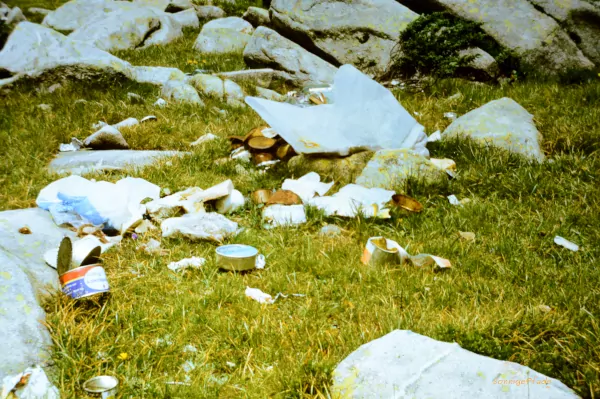
We rest a little more on the shore of the lake. Between the boulders we look for a wind-protected place to prepare a hot soup for dinner on the hiking stove. In the meantime, a few more groups of hikers have gathered in the hut. They are partly Bulgarians, but also some East Germans and Poles. As dusk falls, we lie down in the attic with our sleeping bags. There is no electric light, everyone has to rely on his flashlight. But after the exhausting ascent everybody just wants to sleep anyway.
From Tewnoto Esero the trail first goes west to cross the next saddle – the Превалска порта (Prewalska Gate). Behind it we stay almost on a contour line, to the right and left in the valleys there are more lakes. Then follows the ridge of Голям типиц (Goljam Tipitz), where it goes uphill bit by bit. Another group of mountain hikers meets us from a side path. As it turns out, they are West German youths. The three of them join us, because on the narrow stony paths we can only go in single file. It has become cloudy, so that we are walking in dense clouds. On the ridge it suddenly starts to thunder. Thunder and lightning almost follow each other. We are in the middle of a thunderstorm. Around us it crashes violently. A horror – performance – thunderstorm on the ridge. Right and left steep slopes. Nothing to do but hope. Fortunately, the thunderstorm soon moves off and we can breathe a sigh of relief. None of us has suffered any damage.

It’s strange, but we East Germans and the West Germans don’t have much to say to each other. No idea what the reason is – somehow they seem to be surrounded by a bubble of disinterest. Even during the rest stop, where we sit next to each other, no conversation takes place. Interested and a little bit enviously I examine inconspicuously their equipment. Their backpacks look slimmer and more handy. Both Jan and I are we with wide Kraxen with outside aluminum – frame on the way. This is what is usual at this time in the East for mountain hiking. The West backpacks are rather round, elongated rolls with thick back pads and well-padded straps for shoulders and hips. The sleeping mattresses also look much softer – although I have no complaints about my good old „repair mat“ (that’s the name they were sold under in the GDR). And the hiking boots also seem a bit more solid – the soles of mine are just starting to come off.
After the rest our east-west – coincidence – hiking community dissolves again just as spontaneously as it has come into being. That is, everyone goes his way without a big goodbye.
In the meantime we walk below the „Бъндеришки цркус (Banderishki Circus)“ between the Дългото езеро (Dalgoto esero) and Рибни езеро (Ribni esero). So it goes down again bit by bit. The most exhausting are always the scree fields. You have to go through them, they are just lying across the whole width in the way. The large blocks can be overcome sometimes only with several small jumps from stone to stone. All this with the weight of the Kraxe on the back. Downhill, it’s especially hard on the calves. Tomorrow I will probably have severe muscle soreness in it.


In front of us is already the great massif of Vichren summit and the northern Pirin. But to continue hiking there, you practically have to descend to the Vichren hut first. There are no other possibilities to spend the night in between.
Towards evening we arrive at the small campground at the hut, which I left more than a week ago. This one is still well visited. Mostly Bulgarians live in the hut. It seems to be an attractive vacation spot for many Sofia city dwellers. The Bulgarians are less likely to make cross-country tours with luggage, as is common for us. They apparently prefer to look for permanent quarters and then make day trips with extended picnics on remote mountain meadows.
The next morning I tell Jan that I will no longer go through the northern part of the Pirin. I had already been on the Vichren the week before, and I don’t trust my shoes on the other trails. He takes it calmly. He was prepared to do the whole tour alone anyway. We pack our things together and say goodbye.


Now I’m on the road again all alone. I want to enjoy that right now in peace. As nice as it is with friends, I am fascinated by the freedom to decide ‚go or stay‘. So I do without the bus to the valley and make my way down to Bansko on foot. There is little activity on this small road. A few Bulgarians are in family on the way with backpack and walking stick. Once the bus comes towards me, once a lonely car stands at the side of the road. Slowly I walk down the serpentines, always looking back at the high mountain ridges that still surround me. It is already a fantastic landscape.
Far below, the first gardens appear between the forest patches and hedge strips. There is a lot growing in the warm, light-flooded plain. From the mountains, many small streams flow down the valley. These are „tapped“ – an ingenious, surely ancient irrigation system is fed by them and via many small distribution ditches with simple weirs and shut-off or detour gates, sufficient amounts of water always reach the beds – rows of crops. Tomatoes, peppers, watermelons, corn and many other fruits ripen in the gardens. Old women and men are hoeing and harvesting.
Just before Bansko, a farmer with an ox cart approaches me and gives me a friendly nod. But the place seems largely deserted. It is already quite hot again, the air shimmers in the empty streets. Next to the driveway there is a large sign with information about winter sports in the Pirin Mountains. There are some ski slopes and lifts in the region. There is talk of building cable cars – Bansko is to become above all a winter sports resort. Including venue for international competitions. Well, I don’t like winter very much anyway. And I prefer the area in summer, despite the heat.

Back at the station I think about how to proceed. Actually, I have on the long train ride back to Septemvri no real desire. So I decide to hitchhike. That goes also quite well, lasts nevertheless its time. In the south of Bulgaria one must again and again around high mountains, which extends the distances uncommonly. The heat and the general noon rest do not make the undertaking also straight lighter.
Finally I reach Пловдив (Plovdiv) at the Maritza river. I don’t want to spend much time there – I’ve already been to this city twice. But from here on my return ticket is valid, I can take the train to the north. That means, again through the Stara Planina mountains, only this time in the train.
Late at night I arrive in Veliko Trnovo. Track 3. On track 1 there is a freight train. To get to the station building, I have to climb under or over it. With the Kraxe I do not crawl of course under the train, thus above over. It’s actually easy, always over the brakeman’s platform at the end of the wagon. That’s how it is in Bulgaria.
At the station there are only a few people. Mostly railroad employees – the dispatcher, a few shunters. Not far from the station there is a small bungalow complex uphill. That’s where I want to go now. Because that’s a place where you can just lie down at night. Veliko Trnowo also has an official campground, but first of all I don’t have a tent. Secondly, I remember this campground from two years ago quite unpleasant. At the bungalows everything is quiet. There doesn’t even seem to be anyone around. So I look for my quiet corner and lie down on the meadow with my sleeping mat and sleeping bag.

The next day I set off first thing in the morning to visit aunt Соня (Sonja). Of course, this is not an aunt of mine. Actually an acquaintance of my sister. She works in a big library and speaks German very well. Years ago she came across my sister in the city and talked to her. Since then there was the contact. Two years before, we were in Bulgaria with some friends, and I also met Aunt Sonja.
She is very happy about my surprise visit. In the meantime she has retired and is at home most of the time. Her granddaughter, with the same name Sonja, is also there – that is very good. She is also learning German and is happy to be able to practice on a practical example. She is 13 and is on vacation. One of her friends is also visiting. The two of them take over the city tour for me, because Aunt Sonja is not so good on foot anymore.
Veliko Trnovo is one of the most important historical cities in Bulgaria. Its location alone is impressive. It stretches over three hills, delimited by the gorge-like meanders of the Янтра (Jantra river). At the end of the eighties V. Trnovo has about 64,000 inhabitants. In the vicinity there are some important industrial – enterprises. However, one does not notice too much of it in the city itself. This is rather a spiritual – cultural center of Bulgaria. Veliko Trnovo is home not only to the University of Cyril and Methodius, but also to the University of Education, the University of Applied Sciences and a number of other educational institutions. Veliko Trnovo is also important for the Bulgarian Orthodox Church with 18 church buildings.


For tourists, however, the most interesting are the testimonies of the centuries. In the Sveti Georgi church the princely sons Petar and Assen declared the struggle against the domination of Byzantium, initiating the Bulgarian uprising. On the hill (Tsarevets) there are the remains of the Tsar’s fortress, which became the ruling palace of Bulgaria after the creation of the second Bulgarian Empire from 1187. This period lasted until 1393, during which time the city expanded over the two neighboring hills and the surrounding river valleys.
In 1393 the troops of the Ottomans prevailed and took over the rule of the country in a bloody way. After large parts of the population were massacred or abducted, it took centuries for the city to recover. It was only in connection with the Russian-Turkish War that Veliko Trnovo was liberated from Ottoman rule in 1878. At that time Veliko Trnovo had only about 5700 inhabitants.
Most of the houses in the town center with many narrow streets date back to the 19th century. In the town there are numerous traditional craftsmen such as potters and knife grinders. Today this is interesting mainly for tourists who want to buy local souvenirs. Icon painters can also be found – if not directly in Trnovo, then definitely in the museum village Арбанаси (Arbanasi) a few kilometers further north.

Late in the evening I say goodbye to the Sonjas. It will take almost 10 years until we meet again. But of course we don’t know that yet. With the younger Sonja begins a regular correspondence that lasts all the time. She definitely wants to improve her German. Especially after the collapse of the Eastern Bloc, because she sees hardly any chances for herself in Bulgaria.
The son or father – depending on which Sonja perspective you look at it from – takes me to the train station by car. I am quite happy about that, because the walking all day in the city was exhausting and also to the station it goes up and down hills.
I take a suburban train for a few kilometers to the railroad station Горна Оряховица (Gorna Oryahovitsa). The location of Veliko Trnovo in the mountain valleys entails that the main railroad line is routed through this railroad – cross. Only there the long-distance trains from Sofia arrive to continue their journey to the north and out of Bulgaria. Unfortunately, the Pannonia and other international trains leave Sofia in the evening. I.e. in Gorna they arrive only after midnight. Well, as described in the beginning – most of the train traffic in Bulgaria takes place at night. Sometime after 1 a.m. my train arrives. Later, maybe around 3 a.m., we are at the border near Ruse. And now it’s a quick return, in the truest sense of the word. I now have one day on the train, which I don’t want to leave until Budapest. In Romania I sit between farmers with chickens on their laps, vacationers and a few business travelers. This time I bought a seat reservation card at the counter in Gorna. So no problems with the romanian conductors.
At an en route station in Romania, I want to quickly sell a packet of MONA coffee. This is ready-ground coffee shrink-wrapped in a gold-colored foil. Normally, Rondo coffee is drunk in the GDR. These are whole beans. Almost everyone has a coffee grinder at home. But if you don’t have one, you can grind your coffee on a machine in the vestibule of most grocery stores – open the bag, put the beans in a funnel at the top, clamp the bag to the filler neck at the bottom, and off you go. Almost no one buys MONA. But in Romania, coffee is extremely scarce and therefore easily tradable. The shiny gold bag does the rest. So I stand at the door and hold the package conspicuously inconspicuous in my hand. The train is ready to depart, and someone approaches me. We quickly agree on a deal. While he is still looking for the money, the train is already rolling away. He has to walk next to me.
But no problem. In Romania, there are no announcements on the platform and no hysterical conductors screeching „Diiirn schließüne!!!! Shut the door, damn it!“ like at home. There, the train just starts moving slowly with a horn signal and everyone can still jump on. Only at the end of the platform does it speed up. Finally he has got his Lev together. He hands me the money and I hand him the packet of Mona coffee. Then I climb the last step on the stairs and close the door.
The banknotes are more like old dirty rags. Completely worn and without any „tension“, the print barely visible. But that’s how all the bills looked in end-socialist Romania – even from the „state bank“ in the GDR I didn’t get any others when I exchanged them. The Bulgarian Leva, on the other hand, were partly hot off the press. But with the sale at the wagon door I have practically already compensated my expenses of two days in Brasov/ Kronstadt on the outward journey. So, after my return, I can exchange all Romanian Lev back into GDR mark at the state bank, as if I had not been in Romania at all.
Budapest is simply another breath of fresh air before returning to the GDR. Maybe I’ll buy a new pair of jeans or, better yet, a western record. Last year I bought „Blues from Laurel Canyon“ by John Mayall (for the curious – at that time about 80 East german Mark). That was really a good grab. Blues at its best. I had gone to the Poland Center at the Brühl in Leipzig in the spring of 1988. A blues record was playing there as background – music whose groove triggered storms of enthusiasm in me. In the Poland Center, you could always get things that were produced and sold in the neighboring country. These enriched the „culturally relevant assortment of goods“ for open-minded GDR citizens quite neatly. On the day in question, I asked the saleswoman which record it was. I got a John Mayall LP, recorded live in Szeged, Hungary. If I remember correctly, for the in the GDR usual unit price of 16.10M the good piece. This record had been produced in Poland under license. What I did not know and what the somewhat simplified cover also concealed – the LP was sold in the West under the title „Behind the iron curtain„. Anyway, John Mayall had one more fan from that day on. Until then I didn’t know him, in the GDR there were mainly blues – records of black blues musicians who had participated somewhere in the american folk blues festival. (In 1989 also in the GDR a licensed LP of John Mayall appeared, as usual for 16,10M, „The Power of the Blues„. However, again, without mentioning the title).
In the summer of 1989, however, I didn’t find an LP worth dragging along from Budapest anymore. Instead, I roamed around the city. Rumors made the rounds everywhere. That somehow many GDR citizens had run away to Austria via Hungary, I had already noticed on the way. Also in Bulgaria some had asked me about it. When I sat on the Danube bank in Budapest, opposite the Hungarian parliament building, a young woman asked me whether I wanted to run away. I answered in the negative, I had never intended to do so. It was clear to me that the situation in the GDR was anything but nice. Especially in the weeks before I left, I had some experiences with the police and the Stasi (secret service). But I also saw the counter-movement growing stronger and stronger and felt more and more connected to it. Besides, I always said: ‚I know the problems in the GDR and we can tackle them. Things will have to change there, and I want to be part of it. I don’t even know the problems in the West. Nothing draws me there.‘ Unfortunately, I could not have known at the time that these problems would also be mine not even a year later.

However, if I had known how easy it was to drive over to Vienna at that time, I would have tried it for sure. Shortly to Vienna, send a postcard of St. Stephen’s Cathedral home and then drive back. That would have been fun.
For many East Germans (Ossis), Budapest was still ‚half of the West‘. This was especially evident at the fast-food stall with the golden seagull. There were even at night long queues of GDR citizens who wanted to chew on a piece of McSomething. I could and can only shake my head…

Ah yes, the night. In the years before, it was often the case that the large train stations, Margaret Island in the Danube or some passages at the Chain Bridge were besieged at night by GDR youths, who slept there in long rows. Simply to save on accommodation costs. Protection through mass. Starting in 1988, Hungary began to collect such young people in the evening and take them to a camp outside the city. This was supervised by an aid organization. In 2015, I once saw pictures on the net that compared this camp with the refugee camps. Fits relatively well, especially since a large part of the people in 1989 also just waiting for an opportunity or a smuggler to get across the Austrian border. At that time, Hungary was generous to the GDR citizens.
I went with some other „Ossis“ (people from east (ost) germany = ossi’s) in the evening immediately with the city bus to this camp. In the camp there were a few large tents where one could get a place to sleep. They were not enough by far. But almost all of the young people had a tent with them, which everyone was allowed to set up on the designated meadow areas. There were washrooms, otherwise the equipment was rather poor but sufficient. Alcohol was forbidden. The couple with whom I arrived had a small tent. They kindly took my Kraxe backpack inside so that nothing could be stolen from me. I lay down once again with the Tarp blanket between the tents.

The rule was that the camp had to be completely abandoned in the morning. Take down tents, leave nothing behind. At the entrance there were large cages. There, one could have one’s luggage locked up for a fee and receive it back in the evening. So, no place for permanent residents, the cards were „reshuffled“ every evening.
I didn’t want to settle down for a longer stay anyway, I wanted to continue the next day. So on to the Nyugati Pu. There the trains left to the north, thus also in the direction of the GDR. The large stations in Budapest were probably already from the time of the Danube monarchy and were very well restored. No comparison with the always dingy, run-down GDR stations.
The train I would now take back passed the border with Slovakia in Rajka. Already almost in Austria 😉 Then came immediately Bratislava, the first station of my summer – trip 1989. Behind the border I photographed at least times the back of my „travel card for visa-free travel“ with the many border – stamps. Because at the GDR border is collected. Presumably, so that the Stasi – secret service in case of need a piece of the travel process can trace (the passport control units were part of the Stasi). If I had known that it is the last time that I need such a paper, I would have also photographed the front.

There are many GDR youths on the train. Especially from Prague, practically all seats are occupied. After all, some travel the short distance to the Czechoslovakian capital to spend a weekend with ’some distance‘ and a good black beer in the U Fleku inn. The main topic is of course the refugee wave. So the GDR – refugee wave over Hungary. Whoever was in Hungary or could receive western news via various channels had something to contribute. Some also told of seeing abandoned cars on the side of the road in Hungary or empty tents left standing on the campground. The closer we came to the GDR border at Dećin, the more we joked that the border troops now welcome everyone who returns with a bouquet of flowers.
When the time came, there was a tense silence. Hardly anyone whispered. Nobody had to unpack their suitcases. But the guys were not really friendly. Well, they (almost) never were. There were no flowers. But also the border controllers were obviously tense. The questions and remarks were short and strict. There was something in the air, that was clear. Perhaps they sensed that the exodus was the beginning of the end, that they and their secret comrades in the country were losing more and more control.
Well, after Bad Schandau there is peace. The train curves in long loops along the Elbe valley through Saxon Switzerland. There is not much to see, it is early morning and still dark. From Dresden I get a train to Leipzig, which I leave in Oschatz. From there I can take the bus for the last part.
I am back home. Behind me lies an adventurous journey, my first longer solo venture. Exciting weeks lie ahead of me. From October 9, the decisive day1 in Leipzig of the peaceful revolution in East Germany, everything is different. During this time I can hardly sleep. Not only because of various nocturnal activities. My emotional world is on the upswing, it feels like being newly in love, with lots of butterflies in the stomach. The Stasi has retreated, has lost its terror. And we can start to build something new, finally shape and develop our country ourselves. I’m young, and I want the change – now!
Today, the memory of these events is usually reduced to the „fall of the Wall“ one month later. In other words, the day when the west Germans woke up and rubbed their eyes in amazement ‚what’s going on there in the wild east?‘ But this event, the “fall of the wall” was simply one of the demands and logical consequences of the peaceful revolution in the month before.
O.k., the rest is known. The hangover moved in slowly already in December 89. In March 90 came the hammer with the first election2, in October the annexation. Annexation under Number 233. A country had begun to overcome its paralysis and to shape its own destiny. But caged chickens do not need freedom.
.. some aditional notes of the author:
1 On October 9, 1989, the ruling Communist Party (SED) of the GDR wanted the police, the army and the Stasi secret police to shoot down the increasingly strong Monday demonstrations in Leipzig – just as the Chinese Communists had done a few months earlier in China on Tiananmen Square.
2 In the last elections to the Volkskammer, the parliament of the GDR, in March 1990, a clear majority (47%) voted for the party CDU. Their only election promise was rapid reunification. The CDU’s victory was interpreted by the CDU-led governments in East and West as a mandate to bring about the rapid accession of the GDR, without a referendum.
3 Germany still has only a (former west-german) Basic Law, no constitution. The german constitution should be created according to their inventors only in the course of a reunification of East and West Germany by a common process and referendum – so it provides Article 146 in the Basic Law. Those in power preferred – bypassing the people – to obtain an „accession of the GDR“ in accordance with Article 23 of the Basic Law in force at the time. An annexation, in other words. Many of today’s problems with the „non-integrated East Germans“ can be traced back to this political aberration.
You like the story about a 89’th travel summer?
I will be glad, if you share the link of the post in your social media channels to remember all about the end of cold war and the youth in the time of a separated world. Thank you!
